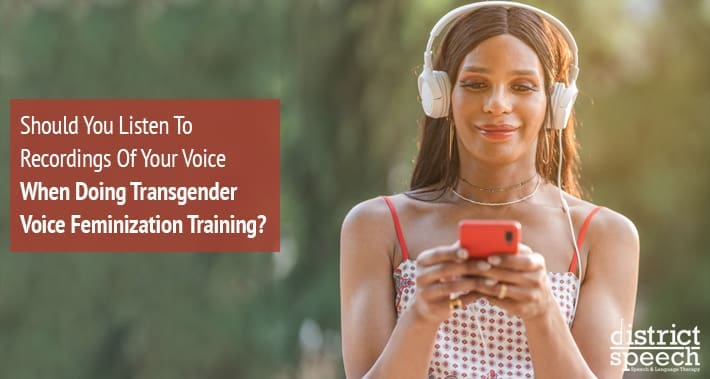
Are you a transgender woman who’s been trying to pick apart how you can train your voice to sound more feminine?
If so, you’ve probably hit Google, YouTube, reddit, and even those old crossdressing forums from the 90s that are still kicking around, trying to find advice on how to feminize your voice.
As a transgender mtf voice training coach, I’ve heard all sorts of things from my clients about how they’ve been trying to train their voice.
And one of the most frequently asked questions about transgender voice training I hear is whether it’s a good idea to make recordings of your voice and listen to them to gauge your progress.
The answer is no, this is a terrible idea.
And the reason has a lot to do with how we experience our own voices in the first place.
Let’s take a closer look.
How Does Hearing Work?
How do you experience the voices of others?
If you’re hearing impaired, you might have gotten pretty good at lip reading, but for the most part, we experience speech through hearing it.
Sound waves enter your outer ear, which amplifies them and guides them into your ear canal.
From there, they hit your eardrum, which vibrates, pushing the sound into your middle ear.
In your middle ear is a chain of the three smallest bones in your body, called ossicles.
They respond to vibrations from your eardrums which amplifies the sound waves further before they head into your inner ear.
The final ossicle in the chain – called the stapes – push on your oval window, a tiny membrane that separates your middle ear from your inner ear.
Sound then enters your cochlea, a fluid filled chamber in your inner ear.
Inside that chamber is the organ of Corti, which translates sound waves into electrical signals your brain can process.
That’s a fairly simplified explanation, but it works for our purposes today.
If you’d like a more in depth outline of how our hearing works, this 2021 article by Madeleine Burry for Healthy Hearing does a great job.
So, this is how we hear others’ voices, and it’s known as “air conduction”.
As in, sound that’s conducted through vibrations in the air particles between the source of the sound and your ears.
But what about our own?
How Do We Experience Our Own Voices?
For our own voices, it’s a little different.
When you speak, your vocal folds at the top of your larynx vibrate, which then resonates in your chest, neck, or head, depending, and there projects outward for others to hear.
Part of that projection will come back into your ears, which ends up working just how we hear everyone else’s voices.
But there’s more to it than that.
Your vocal folds are located in your throat, at the top of your larynx.
And as they vibrate, those vibrations end up traveling along your jawbone, up to your skull, and from there enter your ears.
This is called bone conduction, and it has a distorting effect on how you experience your voice.
Most people think their voice sounds deeper, richer, and fuller than others experience it when they hear it in their own head.

So What Does This Have To Do With Voice Recordings?
When you normally experience your voice, it’s through a mix of air conduction and bone conduction – mostly bone.
But when you listen to a recording of your own voice, all the bone conduction is gone.
You’re left with just air conduction.
What you hear ends up feeling thinner, higher pitched,
This really is a brand new voice compared to the one you’re used to experiencing, and for many people it can cause a bit of an internal crisis.
It can feel like the way you present yourself to the world and the way you’re actually perceived are two different things.
This can trigger feelings of inauthenticity, leaving you to wonder what else about your presentation isn’t the way you thought it was.
And that’s for cis people.
Toss the added complication of gender dysphoria into the mix, and it becomes even more complicated.
You just can’t win.
So What’s The Alternative?
One of the difficulties of learning to train your voice on your own is the fact that it’s so difficult to discern how your own voice actually sounds in isolation.
That’s where a transgender voice coach can help.
I’m Sophie Edwards voice feminization coach here at District Speech And Language Therapy in Washington DC, and if you’re able to train your voice on your own, that’s great – go for it.
But if you feel stuck, like you just can’t parse through all the information out there, I’m here to help.
Book your appointment with District Speech today.
1300 I St NW, #400E,
Washington, DC 20005
- https://g.page/districtspeech
District Speech and Language Therapy specializes in speech therapy, physical therapy, and occupational therapy solutions, for both children and adults, in the Washington D.C and the Arlington Virginia areas.